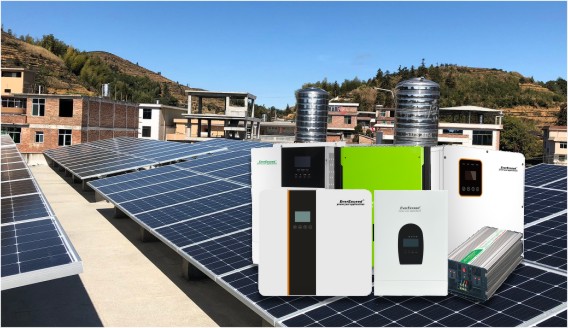Products
Clean Energy

1
Solar Panels
Solar panels are devices that convert solar energy into electrical energy using the photovoltaic effect. They are composed of solar cells made of semiconductor materials that generate an electric current when exposed to sunlight. Solar panels come in various shapes and sizes, differing in manufacturing techniques, conversion efficiency, and prices. The main types of solar panels include:
- Multi-Crystalline Silicon Panels: These panels are the most common and widely used in the market, consisting of multiple silicon crystals. Although they have medium efficiency, they are considered a cost-effective option.
- Monocrystalline Silicon Panels: These panels are more efficient than multi-crystalline panels, made from a single large silicon crystal. They feature high performance and higher conversion efficiency but are more expensive than other types.
- Thin-Film Panels: This technology uses thin layers of semiconductor materials such as silicon, cadmium, and copper to form the solar cell. They are characterized by flexibility, lightweight, and low production costs, but have lower efficiency compared to other solar panels.
- Organic Photovoltaic Panels: These panels rely on organic materials called polymers or small organic compounds to generate energy. They are flexible, lightweight, and bendable in design, but do not achieve the same efficiency as traditional solar panels.
These are some common types of solar panels, differing in performance, cost, and suitable applications for each type.

2
Solar Inverters
A solar inverter is a device that converts direct current (DC), generated by solar panels, into alternating current (AC) suitable for use in homes or businesses. The Solar inverter is considered an essential part of grid-tied solar power systems, facilitating the distribution of generated solar energy to the electrical grid and its use in operating household and commercial appliances and systems. Several types of Solar inverters are available based on their uses and designs, including:
- String Inverters: These types are used in small to medium solar systems, converting the energy of many connected solar panels into alternating current. They are economical options and easy to install.
- Microinverters: These devices are installed individually under each solar panel and convert the energy of each panel directly into alternating current. Microinverters are useful in systems that include geographically dispersed solar panels.
- Hybrid Inverters: These types of devices combine Solar inverter functions with energy storage systems such as storage batteries, enabling the storage of generated solar energy for later use.
Uses of Solar inverters include:
- Converting generated solar energy from solar panels into alternating current for operating household and commercial appliances.
- Distributing excess solar energy to the electrical grid for credit or compensation.
- Storing generated solar energy in batteries for use during nighttime or power outages.
- Ensuring smooth and efficient operation of solar power systems.

3
Batteries
The batteries used in solar power systems are crucial for storing generated solar energy for use during nighttime or power outages. Several types of batteries used in these systems include:
- Lead Acid Batteries:
- Sealed Lead Acid Batteries: These batteries are common, with low cost and good performance. They can be used in small to medium systems.
- Flooded Lead Acid Batteries: Require periodic maintenance for distilled water filling and are used in larger systems, with relatively low cost.
- Lithium Batteries:
- Lithium-ion Batteries: Modern batteries offering high efficiency, long life cycles, and lightweight. They are an excellent choice for large and medium-sized solar applications.
- Lithium Iron Phosphate Batteries: Known for stable performance and high safety, ideal for applications requiring high stability like home solar systems.
- Nickel-Cadmium Batteries: Durable batteries that withstand high temperatures but require periodic maintenance and contain environmentally harmful materials.
- Next Generation Batteries: Include technologies such as Vanadium, Zinc, and Flow batteries, representing innovative batteries that may define the future of solar energy.
Features of batteries used in solar power systems include long life cycles, high efficiency, ability to withstand high and low temperatures, and operational suitability in variable conditions. Battery features and performance vary by type and technology, and choosing the appropriate battery depends on system requirements and environmental factors.
